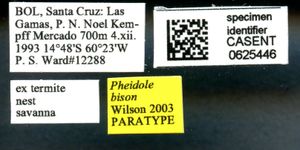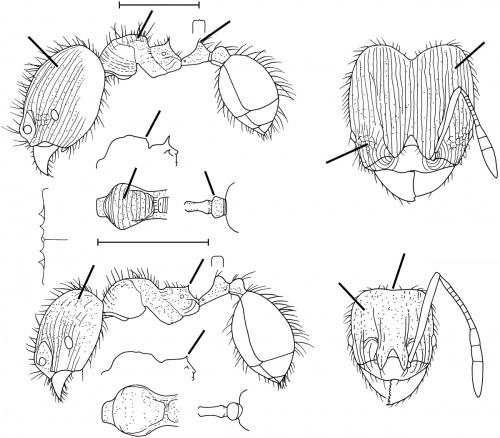Pheidole bison
| Pheidole bison | |
|---|---|

| |
| Scientific classification | |
| Kingdom: | Animalia |
| Phylum: | Arthropoda |
| Class: | Insecta |
| Order: | Hymenoptera |
| Family: | Formicidae |
| Subfamily: | Myrmicinae |
| Tribe: | Attini |
| Genus: | Pheidole |
| Species: | P. bison |
| Binomial name | |
| Pheidole bison Wilson, 2003 | |
The type series was collected by Philip S. Ward from a termite nest in savanna. (Wilson 2003)
Identification
See the description in the nomenclature section.
Keys including this Species
Distribution
Only known from the type locality.
Latitudinal Distribution Pattern
Latitudinal Range: -14.8° to -28.4°.
| North Temperate |
North Subtropical |
Tropical | South Subtropical |
South Temperate |
- Source: AntMaps
Distribution based on Regional Taxon Lists
Neotropical Region: Argentina, Bolivia (type locality).
Distribution based on AntMaps
Distribution based on AntWeb specimens
Check data from AntWeb
Countries Occupied
| Number of countries occupied by this species based on AntWiki Regional Taxon Lists. In general, fewer countries occupied indicates a narrower range, while more countries indicates a more widespread species. |

|
Estimated Abundance
| Relative abundance based on number of AntMaps records per species (this species within the purple bar). Fewer records (to the left) indicates a less abundant/encountered species while more records (to the right) indicates more abundant/encountered species. |

|
Biology
Castes
Worker
Minor
Images from AntWeb
    
| |
| Paratype Pheidole bison. Worker. Specimen code casent0625446. Photographer Jeremy Pilllow, uploaded by University of Utah. | Owned by MCZC. |
Major
Images from AntWeb

| |
| Paratype Pheidole bison. Worker (major/soldier). Specimen code jtlc000016329. Photographer Jeremy Pilllow, uploaded by University of Utah. | Owned by MCZC. |
Nomenclature
The following information is derived from Barry Bolton's Online Catalogue of the Ants of the World.
- bison. Pheidole bison Wilson, 2003: 665, figs. (s.w.) BOLIVIA.
Unless otherwise noted the text for the remainder of this section is reported from the publication that includes the original description.
Description
DIAGNOSIS A medium-sized member of the tristis group similar to Pheidole bellatrix, Pheidole napoensis and Pheidole pullula, differing as follows.
Major: promesonotum a single massive piece, its dorsal border forming a single convexity that drops vertically at the rear to the metanotum; head entirely covered with longitudinal carinulae except for frontal triangle and central section of clypeus; space between eye and antennal fossa rugoreticulate; petiolar node in side view tapered apically to a blunt point; postpetiolar node from above trapezoidal.
Minor: almost all of head and mesosoma foveolate and opaque; irregular broken rugulae present on posterior dorsal head surface; propodeal spines reduced to denticles; occiput broad, weakly concave.
MEASUREMENTS (mm) Holotype major: HW 1.26, HL 1.30, SL 0.76, EL 0.12, PW 0.60. Paratype minor: HW 0.62, HL 0.64, SL 0.64, EL 0.08, PW 0.44.
COLOR Major: head dark reddish brown, rest of body medium reddish brown, appendages light reddish brown.
Minor: concolorous brownish yellow.
Figure. Upper: holotype, major. Lower: paratype minor. Scale bars = 1 mm.
Type Material
BOLIVIA: La Games, Parque Nacional Noel Kempff Mercado, Santa Cruz, 14°48'S 60°23'W, 700 m, col. Philip S. Ward. Museum of Comparative Zoology
Etymology
L Gr bison, the wisent (European bison), alluding to the massive humped back of the major.
References
- Wilson, E. O. 2003. Pheidole in the New World: A dominant, hyperdiverse ant genus. Harvard University Press, Cambridge, MA. (page 665, fig. major, minor described)
- Casadei-Ferreira, A., Fischer, G., Economo, E.P. 2020. Evidence for a thoracic crop in the workers of some Neotropical Pheidole species (Formicidae: Myrmicinae). Arthropod Structure, Development 59, 100977 (doi:10.1016/J.ASD.2020.100977).
References based on Global Ant Biodiversity Informatics
- Fernández, F. and S. Sendoya. 2004. Lista de las hormigas neotropicales. Biota Colombiana Volume 5, Number 1.



